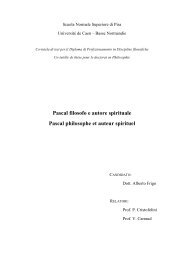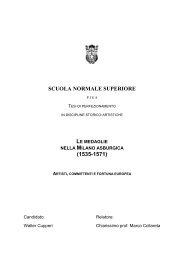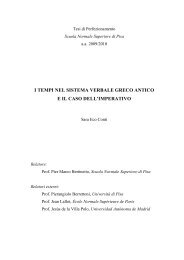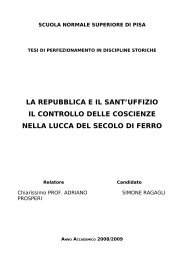CATULLUS 68 - Scuola Normale Superiore
CATULLUS 68 - Scuola Normale Superiore
CATULLUS 68 - Scuola Normale Superiore
Create successful ePaper yourself
Turn your PDF publications into a flip-book with our unique Google optimized e-Paper software.
82 una atque altera rursus unus atque (or et) alter ‘a couple (of)’ is a set phrase, apparently urbane and<br />
somewhat elevated; among poets it is only used by Horace (1x Sat., 2x Epist., 1x A.P.), Ovid (6x, but not in<br />
Met.) and Juvenal (1x), while in prose it is found in Cicero (5x orat., 1x epist.), Sallust (2x), Valerius<br />
Maximus (1x), Columella (2x), Tacitus (1x Dial. and 1x Hist.), Suetonius (8x), Gellius (4x) and Apuleius<br />
(1x, in Met.). It can either stand for ‘two’, as at Cic. Clu. 38 cum unum iam et alterum diem desideraretur,<br />
Att. 14.18.1 tuis et unis et alteris litteris and Ov. Her. 15.182 et sub ea uersus unus et alter erunt (referring to<br />
the subsequent distich), or for ‘a few’, ‘not many’, as at Hor. Epist. 2.1.74 si uersus paulo concinnior unus et<br />
alter and Colum. 4.27.6 pampinos summouere, nisi ad renouandam uitem unus atque alter seruandus est.<br />
Here the former meaning seems more likely.<br />
hiems Since O writes hyemps, while G and R have hyems, the spelling hiemps is adopted by Lucian Müller<br />
in his edition. It is also proposed by Cremona (1958: 426f.). For the epenthetic p compare the perfects<br />
dempsi and sumpsi as well as Vulgar Latin autumpnus, contempno, dampnum, sompnus. The spelling hiemps<br />
is attested at least once in authoritative MSS of authors including Cicero, Caesar, Varro, Horace, Virgil,<br />
Livy, Celsus, Columella and Tacitus (see TLL 6.3.2773.64-83 and Neue-Wagener 1 3 .217f.), while the<br />
Hadrianic grammarian Terentius Scaurus has to point out twice that the correct form is not hiemps but hiems<br />
(GL 7.21.6-9 and 7.27.3-17): evidently both were use in his time. In the epigraphic evidence we find hiemps<br />
(CIL 1 2 p. 281 [f].9 = CIL 6.32505, from somewhere in Italy) alongside hi ems (CIL 8.12588, from Carthage)<br />
and iemns (CIL 14.2030, from Ostia; the date of all three inscriptions is uncertain). Since O is less innovative<br />
than X (= GR), it is more likely to conserve the reading of the archetype, though it is also more likely to<br />
make foolish errors; but in any case if the p was present in the archetype, it could well have been inserted by<br />
someone during Antiquity or the Middle Ages. See further the Introduction, p. 80.<br />
83 noctibus in longis Nights are longer during the winter and Catullus assumes that it is then that<br />
Laodamia would have been able to satiate herself with love-making (on indoor activities during winter nights<br />
compare Verg. Geo. 1.291-296).<br />
auidum saturasset amorem A phrase that appears surprisingly and even suspiciously modern, but there<br />
are parallels for auidus as well as for saturo: compare Var. Men. 342 Astbury postquam auida libido rapere<br />
ac comedere (the reading is uncertain) coepit and Cic. Cato 39 uoluptatem corporis … cuius uoluptatis<br />
auidae libidines temere et ecfrenate ad potiendum incitarentur for the former and Cat. 64.119f. nondum /<br />
lumina sunt gnati cara saturata figura and Rhet. Her. 4.65 exple meas inimicitias et iracundiam satura tuo<br />
sanguine for the latter.<br />
84 abrupto … coniugio For abrumpo ‘to interrupt’, ‘to end prematurely’ compare esp. Sidon. Epist. 9.6.1<br />
abrupto contubernio ancillae and also Verg. Aen. 8.579 nunc, o nunc liceat crudelem abrumpere uitam with<br />
9.497, and CE 1219.1-3 = CIL 6.25871.1-3 uiginti duo erant anni … abrupit dirae sortis iniqua dies (see<br />
further TLL 1.141.3-71). It is a strong word.<br />
200






